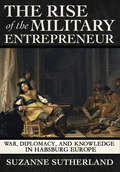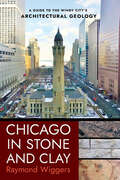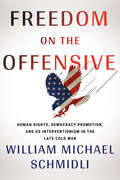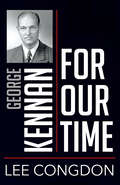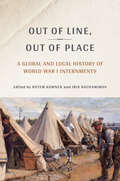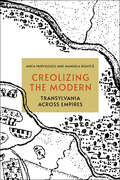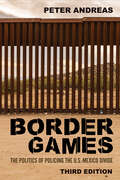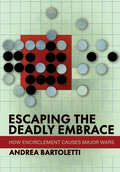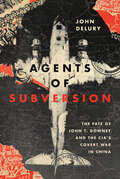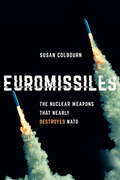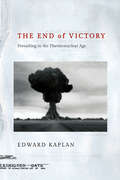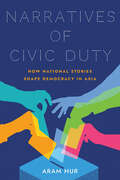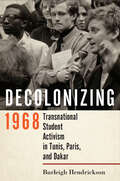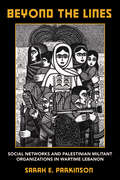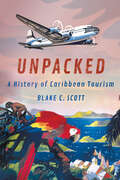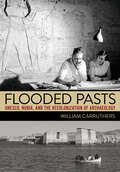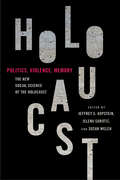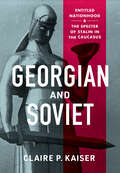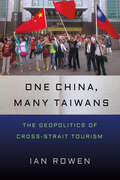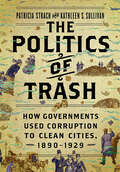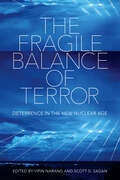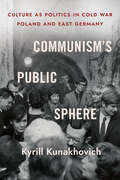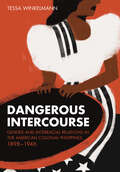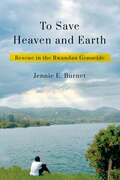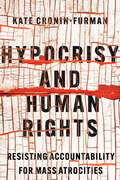- Table View
- List View
The Rise of the Military Entrepreneur: War, Diplomacy, and Knowledge in Habsburg Europe
by Suzanne SutherlandThe Rise of the Military Entrepreneur explores how a new kind of international military figure emerged from, and exploited, the seventeenth century's momentous political, military, commercial, and scientific changes. In the era of the Thirty Years' War, these figures traveled rapidly and frequently across Europe using private wealth, credit, and connections to raise and command the armies that rulers desperately needed. Their careers reveal the roles international networks, private resources, and expertise played in building and at times undermining the state.Suzanne Sutherland uncovers the influence of military entrepreneurs by examining their activities as not only commanders but also diplomats, natural philosophers, information brokers, clients, and subjects on the battlefield, as well as through strategic marital and family allegiances. Sutherland focuses on Raimondo Montecuccoli (1609–80), a middling nobleman from the Duchy of Modena, who became one of the most powerful men in the Austrian Habsburg monarchy and helped found a new discipline, military science. The Rise of the Military Entrepreneur explains how Montecuccoli successfully met battlefield, court, and family responsibilities while contributing to the world of scholarship on an often violent, fragmented political-military landscape. As a result, Sutherland shifts the perspective on war away from the ruler and his court to instead examine the figures supplying force, along with their methods, networks, and reflections on those experiences.
Chicago in Stone and Clay: A Guide to the Windy City's Architectural Geology
by Raymond WiggersChicago in Stone and Clay explores the interplay between the city's most architecturally significant sites, the materials they're made of, and the sediments and bedrock they are anchored in. This unique geologist's survey of Windy City neighborhoods demonstrates the fascinating and often surprising links between science, art, engineering, and urban history. Drawing on two decades of experience leading popular geology tours in Chicago, Raymond Wiggers crafted this book for readers ranging from the region's large community of amateur naturalists, "citizen scientists," and architecture buffs to geologists, architects, educators, and other professionals seeking a new perspective on the themes of architecture and urbanism. Unlike most geology and architecture books, Chicago in Stone and Clay is written in the informal, accessible style of a natural history tour guide, humanizing the science for the nonspecialist reader. Providing an exciting new angle on both architecture and natural history, Wiggers uses an integrative approach that incorporates multiple themes and perspectives to demonstrate how the urban environment presents us with a rich geologic and architectural legacy.
Freedom on the Offensive: Human Rights, Democracy Promotion, and US Interventionism in the Late Cold War (The United States in the World)
by William Michael SchmidliIn Freedom on the Offensive, William Michael Schmidli illuminates how the Reagan administration's embrace of democracy promotion was a defining development in US foreign relations in the late twentieth century. Reagan used democracy promotion to refashion the bipartisan Cold War consensus that had collapsed in the late 1960s amid opposition to the Vietnam War. Over the course of the 1980s, the initiative led to a greater institutionalization of human rights—narrowly defined to include political rights and civil liberties and to exclude social and economic rights—as a US foreign policy priority. Democracy promotion thus served to legitimize a distinctive form of US interventionism and to underpin the Reagan administration's aggressive Cold War foreign policies. Drawing on newly available archival materials, and featuring a range of perspectives from top-level policymakers and politicians to grassroots activists and militants, this study makes a defining contribution to our understanding of human rights ideas and the projection of American power during the final decade of the Cold War. Using Reagan's undeclared war on Nicaragua as a case study in US interventionism, Freedom on the Offensive explores how democracy promotion emerged as the centerpiece of an increasingly robust US human rights agenda. Yet, this initiative also became intertwined with deeply undemocratic practices that misled the American people, violated US law, and contributed to immense human and material destruction. Pursued through civil society or low-cost military interventions and rooted in the neoliberal imperatives of US-led globalization, Reagan's democracy promotion initiative had major implications for post–Cold War US foreign policy.
George Kennan for Our Time (People for Our Time)
by Lee CongdonGeorge Kennan for Our Time examines the work and thought of the most distinguished American diplomat of the twentieth century and extracts lessons for today. In his writings and lectures, Kennan outlined the proper conduct of foreign policy and issued warnings to an American society on the edge of the abyss. Lee Congdon identifies the principles Kennan applied to US relations with Russia and Eastern Europe, and to the Far and Near East. He takes particular note of Kennan's role in formulating postwar policy in Japan, measured response to North Korea's invasion of South Korea, and opposition to the war in Vietnam. Congdon also considers Kennan's strong criticisms of his own country, its egalitarianism, unrestricted immigration, and multiple addictions. He cites Kennan's call for a greater closeness to nature, a revival of religious faith, and a return to the representative government established by the Founding Fathers. George Kennan for Our Time describes the often-disastrous results of rejecting Kennan's counsel, and the dangers, international and national, posed by an ongoing failure to draw upon his wisdom. In view of America's foreign policy disasters in Afghanistan, Iraq, and around the world, Kennan's realist approach provides important lessons for our current age.
Out of Line, Out of Place: A Global and Local History of World War I Internments
by Rotem Kowner Iris RachamimovWith expert scholars and great sensitivity, Out of Line, Out of Place illuminates and analyzes how the proliferation of internment camps emerged as a biopolitical tool of governance. Although the internment camp developed as a technology of containment, control, and punishment in the latter part of the nineteenth century mainly in colonial settings, it became universal and global during the Great War.Mass internment has long been recognized as a defining experience of World War II, but it was a fundamental experience of World War I as well. More than eight million soldiers became prisoners of war, more than a million civilians became internees, and several millions more were displaced from their homes, with many placed in securitized refugee camps. For the first time, Out of Line, Out of Place brings these different camps together in conversation. Rotem Kowner and Iris Rachamimov emphasize that although there were differences among camps and varied logic of internment in individual countries, there were also striking similarities in how camps operated during the Great War.
Creolizing the Modern: Transylvania across Empires
by Anca Parvulescu Manuela BoatcăHow are modernity, coloniality, and interimperiality entangled? Bridging the humanities and social sciences, Anca Parvulescu and Manuela Boatcă provide innovative decolonial perspectives that aim to creolize modernity and the modern world-system. Historical Transylvania, at the intersection of the Habsburg Empire, the Ottoman Empire, Austria-Hungary, and Russia, offers the platform for their multi-level reading of the main themes in Liviu Rebreanu's 1920 novel Ion. Topics range from the question of the region's capitalist integration to antisemitism and the enslavement of Roma to multilingualism, gender relations, and religion. Creolizing the Modern develops a comparative method for engaging with areas of the world that have inherited multiple, conflicting imperial and anti-imperial histories.
Border Games: The Politics of Policing the U.S.-Mexico Divide
by Peter AndreasIn this third edition of Border Games, Peter Andreas charts the rise and transformation in policing the flow of drugs and migrants across the US-Mexico border. Recent border crackdowns and wall-building campaigns, he argues, are not unprecedented. Rather, they are the outcome of an escalatory dynamic already in motion—but now played out on a far bigger stage, with higher stakes, and in new security and political contexts. Focusing on the power of symbolic politics and policy feedback effects, Andreas traces the logic behind such buildup. Border policing is an attractive political mechanism for handling the often unintended consequences of past policy choices, signaling a commitment to territorial integrity and projecting an image of territorial authority. Yet its negative aftermath is not only frequently glossed over; it also fuels further escalation. With new chapters on the border policies of the Obama, Trump, and Biden administrations, Border Games continues to help readers grasp how the busiest border in the world is also one of the most fortified, and why it plays such a complicated and contentious role in both domestic politics and US-Mexico relations.
Escaping the Deadly Embrace: How Encirclement Causes Major Wars (Cornell Studies in Security Affairs)
by Andrea BartolettiEncirclement, Andrea Bartoletti argues, is an essential strategic possibility of the international system and a key trigger of major war. Using historical case studies, Escaping the Deadly Embrace examines how great powers try to escape the two-front war problem and seek to preserve their security. Encirclement is a geographic variable that occurs in the presence of one or two great powers on two different borders of the surrounded great power. The surrounding great powers may not have the capacity to initiate a joint invasion. Yet their threatening presence triggers a double security dilemma for the encircled great power, which has to disperse its army to secure its borders. When the surrounding great powers become capable of launching a two-front attack, the encircled great power initiates war. This situation, disastrous in itself, can also lead to war contagion when other great powers intervene in the new conflict owing to the rival-based network of alliances. Combining archival work and historiographical analysis, Escaping the Deadly Embrace demonstrates the efficacy of this by assessing three major wars: the Italian Wars, the Thirty Years' War, and World War I. These findings, Bartoletti shows, have important implications for future major wars. Challenging the current focus on the US-China rivalry, he argues that the most concerning strategic scenario is the encirclement of China by India and Russia.
Agents of Subversion: The Fate of John T. Downey and the CIA's Covert War in China
by John DeluryAgents of Subversion reconstructs the remarkable story of a botched mission into Manchuria, showing how it fit into a wider CIA campaign against Communist China and highlighting the intensity—and futility—of clandestine operations to overthrow Mao. In the winter of 1952, at the height of the Korean War, the CIA flew a covert mission into China to pick up an agent. Trained on a remote Pacific island, the agent belonged to an obscure anti-communist group known as the Third Force based out of Hong Kong. The exfiltration would fail disastrously, and one of the Americans on the mission, a recent Yale graduate named John T. Downey, ended up a prisoner of Mao Zedong's government for the next twenty years. Unraveling the truth behind decades of Cold War intrigue, John Delury documents the damage that this hidden foreign policy did to American political life. The US government kept the public in the dark about decades of covert activity directed against China, while Downey languished in a Beijing prison and his mother lobbied desperately for his release. Mining little-known Chinese sources, Delury sheds new light on Mao's campaigns to eliminate counterrevolutionaries and how the chairman of the Chinese Communist Party used captive spies in diplomacy with the West. Agents of Subversion is an innovative work of transnational history, and it demonstrates both how the Chinese Communist regime used the fear of special agents to tighten its grip on society and why intellectuals in Cold War America presciently worried that subversion abroad could lead to repression at home.
Euromissiles: The Nuclear Weapons That Nearly Destroyed NATO
by Susan ColbournIn Euromissiles, Susan Colbourn tells the story of the height of nuclear crisis and the remarkable waning of the fear that gripped the globe. In the Cold War conflict that pitted nuclear superpowers against one another, Europe was the principal battleground. Washington and Moscow had troops on the ground and missiles in the fields of their respective allies, the NATO nations and the states of the Warsaw Pact. Euromissiles—intermediate-range nuclear weapons to be used exclusively in the regional theater of war—highlighted how the peoples of Europe were dangerously placed between hammer and anvil. That made European leaders uncomfortable and pushed fearful masses into the streets demanding peace in their time. At the center of the story is NATO. Colbourn highlights the weakness of the alliance seen by many as the most effective bulwark against Soviet aggression. Divided among themselves and uncertain about the depth of US support, the member states were riven by the missile issue. This strategic crisis was, as much as any summit meeting between US president Ronald Reagan and Soviet general secretary Mikhail Gorbachev, the hinge on which the Cold War turned. Euromissiles is a history of diplomacy and alliances, social movements and strategy, nuclear weapons and nagging fears, and politics. To tell that history, Colbourn takes a long view of the strategic crisis—from the emerging dilemmas of allied defense in the early 1950s through the aftermath of the INF Treaty thirty-five years later. The result is a dramatic and sweeping tale that changes the way we think about the Cold War and its culmination.
The End of Victory: Prevailing in the Thermonuclear Age
by Edward KaplanThe End of Victory recounts the costs of failure in nuclear war through the work of the most secret deliberative body of the National Security Council, the Net Evaluation Subcommittee (NESC). From 1953 onward, US leaders wanted to know as precisely as possible what would happen if they failed in a nuclear war—how many Americans would die and how much of the country would remain. The NESC told Presidents Dwight Eisenhower and John F. Kennedy what would be the result of the worst failure of American strategy—a maximum-effort surprise Soviet nuclear assault on the United States. Edward Kaplan details how NESC studies provided key information for presidential decisions on the objectives of a war with the USSR and on the size and shape of the US military. The subcommittee delivered its annual reports in a decade marked by crises in Berlin, Quemoy and Matsu, Laos, and Cuba, among others. During these critical moments and day-to-day containment of the USSR, the NESC's reports offered the best estimates of the butcher's bill of conflict and of how to reduce the cost in American lives.Taken with the intelligence community's assessment of the probability of a surprise attack, the NESC's work framed the risks of US strategy in the chilliest years of the Cold War. The End of Victory reveals how all policy decisions run risks—and ones involving military force run grave ones—though they can rarely be known with precision.
Narratives of Civic Duty: How National Stories Shape Democracy in Asia (Studies of the Weatherhead East Asian Institute, Columbia University)
by Aram HurIn Narratives of Civic Duty, Aram Hur investigates the impulse behind a sense of civic duty in democracies. Why do some citizens feel a responsibility to vote, pay taxes, or take up arms in defense of one's country? Through comparing democratic societies in East Asia and elsewhere, Hur shows that the sense of obligation to be a good citizen—upon which the resilience of a democracy depends—emerges from a force long thought to be detrimental to democracy itself: national attachments.Nationalism's illiberal and exclusive tendencies are typically viewed as disruptive to democratic processes, but Hur argues that there is nothing inherently antidemocratic about nationalism. Rather, whether nationalism helps or hinders democracy is shaped by the historicized relationship between a national people and their democratic state. When national stories portray that relationship as one of mutual commitment, nationalism strengthens democracies by motivating widespread civic duty among citizens. Drawing on personal narratives, statistical surveys, and experiments, Narratives of Civic Duty offers a provocative national theory of civic duty that cuts to the heart of what makes democracies thrive.
Decolonizing 1968: Transnational Student Activism in Tunis, Paris, and Dakar
by Burleigh HendricksonDecolonizing 1968 explores how activists in 1968 transformed university campuses across Europe and North Africa into sites of contestation where students, administrators, and state officials collided over definitions of modernity and nationhood after empire. Burleigh Hendrickson details protesters' versions of events to counterbalance more visible narratives that emerged from state-controlled media centers and ultimately describes how the very education systems put in place to serve the French state during the colonial period ended up functioning as the crucible of postcolonial revolt. Hendrickson not only unearths complex connections among activists and their transnational networks across Tunis, Paris, and Dakar but also weaves together their overlapping stories and participation in France's May '68.Using global protest to demonstrate the enduring links between France and its former colonies, Decolonizing 1968 traces the historical relationships between colonialism and 1968 activism, examining transnational networks that emerged and new human and immigrants' rights initiatives that directly followed. As a result, Hendrickson reveals that 1968 is not merely a flashpoint in the history of left-wing protest but a key turning point in the history of decolonization.Thanks to generous funding from Penn State and its participation in TOME (Toward an Open Monograph Ecosystem), the ebook editions of this book are available as Open Access volumes from Cornell Open (cornellpress.cornell.edu/cornell-open) and other repositories.
Beyond the Lines: Social Networks and Palestinian Militant Organizations in Wartime Lebanon
by Sarah E. ParkinsonBeyond the Lines explores the social underpinnings of rebel adaptation and resilience. How do rebel groups cope with crises such as repression, displacement, and fragmentation? What explains changes in militant organizations' structures and behaviors over time? Drawing on nearly two years of ethnographic research, Sarah E. Parkinson traces shifts in Palestinian militant groups' internal structures and practices during the civil war of 1975 to 1990 and foreign occupations of Lebanon. She shows that most militants approach asymmetrical warfare as a series of challenges centered around information and logistics, characterized by problems such as supplying constantly mobile forces, identifying collaborators, disrupting rival belligerents' operations, and providing essential services like healthcare. Effective negotiation of these challenges contributes to militant organizations' resilience and survival. In this context, the foundation of rebel resilience lies with militants' ability to repurpose their everyday social networks to organizational ends. In the Lebanese setting, Beyond the Lines demonstrates how regionalized differences in Israeli, Syrian, and Lebanese deployment of violence triggered distinct social network responses that led to divergent organizational outcomes for Palestinian militants.
Unpacked: A History of Caribbean Tourism (Histories and Cultures of Tourism)
by Blake C. ScottUnpacked offers a critical, novel perspective on the Caribbean's now taken-for-granted desirability as a tourist's paradise. Dreams of a tropical vacation have become a quintessential aspect of the modern Caribbean, as millions of tourists travel to the region and spend extravagantly to pursue vacation fantasies. At the beginning of the twentieth century, however, travelers from North America and Europe thought of the Caribbean as diseased, dangerous, and, according to many observers, "the white man's graveyard." How then did a trip to the Caribbean become a supposedly fun and safe experience?Unpacked examines the historical roots of the region's tourism industry by following a well-traveled sea route linking the US East Coast with the island of Cuba and the Isthmus of Panama. Blake C. Scott describes how the cultural and material history of US imperialism became the heart of modern Caribbean tourism. In addition, he explores how advances in tropical medicine, perceptions of the tropical environment, and development of infrastructure and transportation networks opened a new playground for visitors.
Flooded Pasts: UNESCO, Nubia, and the Recolonization of Archaeology
by William CarruthersFlooded Pasts examines a world famous yet critically underexamined event—UNESCO's International Campaign to Save the Monuments of Nubia (1960–80)—to show how the project, its genealogy, and its aftermath not only propelled archaeology into the postwar world but also helped to "recolonize" it. In this book, William Carruthers asks how postwar decolonization took shape and what role a colonial discipline like archaeology—forged in the crucible of imperialism—played as the "new nations" asserted themselves in the face of the global Cold War.As the Aswan High Dam became the centerpiece of Gamal Abdel Nasser's Egyptian revolution, the Nubian campaign sought to salvage and preserve ancient temples and archaeological sites from the new barrage's floodwaters. Conducted in the neighboring regions of Egyptian and Sudanese Nubia, the project built on years of Nubian archaeological work conducted under British occupation and influence. During that process, the campaign drew on the scientific racism that guided those earlier surveys, helping to consign Nubians themselves to state-led resettlement and modernization programs, even as UNESCO created a picturesque archaeological landscape fit for global media and tourist consumption. Flooded Pasts describes how colonial archaeological and anthropological practices—and particularly their archival and documentary manifestations—created an ancient Nubia severed from the region's population. As a result, the Nubian campaign not only became fundamental to the creation of UNESCO's 1972 World Heritage Convention but also exposed questions about the goals of archaeology and heritage and whether the colonial origins of these fields will ever be overcome.
Politics, Violence, Memory: The New Social Science of the Holocaust
by Jeffrey S. Kopstein Jelena Subotić Susan WelchPolitics, Violence, Memory highlights important new social scientific research on the Holocaust and initiates the integration of the Holocaust into mainstream social scientific research in a way that will be useful both for social scientists and historians. Until recently social scientists largely ignored the Holocaust despite the centrality of these tragic events to many of their own concepts and theories. In Politics, Violence, Memory the editors bring together contributions to understanding the Holocaust from a variety of disciplines, including political science, sociology, demography, and public health. The chapters examine the sources and measurement of antisemitism; explanations for collaboration, rescue, and survival; competing accounts of neighbor-on-neighbor violence; and the legacies of the Holocaust in contemporary Europe. Politics, Violence, Memory brings new data to bear on these important concerns and shows how older data can be deployed in new ways to understand the "index case" of violence in the modern world.
Georgian and Soviet: Entitled Nationhood and the Specter of Stalin in the Caucasus
by Claire P. KaiserGeorgian and Soviet investigates the constitutive capacity of Soviet nationhood and empire. The Soviet republic of Georgia, located in the mountainous Caucasus region, received the same nation-building template as other national republics of the USSR. Yet Stalin's Georgian heritage, intimate knowledge of Caucasian affairs, and personal involvement in local matters as he ascended to prominence left his homeland to confront a distinct set of challenges after his death in 1953.Utilizing Georgian archives and Georgian-language sources, Claire P. Kaiser argues that the postwar and post-Stalin era was decisive in the creation of a "Georgian" Georgia. This was due not only to the peculiar role played by the Stalin cult in the construction of modern Georgian nationhood but also to the subsequent changes that de-Stalinization wrought among Georgia's populace and in the unusual imperial relationship between Moscow and Tbilisi. Kaiser describes how the Soviet empire could be repressive yet also encourage opportunities for advancement—for individual careers as well as for certain nationalities. The creation of national hierarchies of entitlement could be as much about local and republic-level imperial imaginations as those of a Moscow center.Georgian and Soviet reveals that the entitled, republic-level national hierarchies that the Soviet Union created laid a foundation for the claims of nationalizing states that would emerge from the empire's wake in 1991. Today, Georgia still grapples with the legacies of its Soviet century, and the Stalin factor likewise lingers as new generations of Georgians reevaluate the symbiotic relationship between Soso Jughashvili and his native land.
One China, Many Taiwans: The Geopolitics of Cross-Strait Tourism
by Ian RowenOne China, Many Taiwans shows how tourism performs and transforms territory. In 2008, as the People's Republic of China pointed over a thousand missiles across the Taiwan Strait, it sent millions of tourists in the same direction with the encouragement of Taiwan's politicians and businesspeople. Contrary to the PRC's efforts to use tourism to incorporate Taiwan into an imaginary "One China," tourism aggravated tensions between the two polities, polarized Taiwanese society, and pushed Taiwanese popular sentiment farther toward support for national self-determination. Consequently, Taiwan was performed as a part of China for Chinese group tourists versus experienced as a place of everyday life. Taiwan's national identity grew increasingly plural, such that not just one or two, but many Taiwans coexisted, even as it faced an existential military threat. Ian Rowen's treatment of tourism as a political technology provides a new theoretical lens for social scientists to examine the impacts of tourism in the region and worldwide.
The Politics of Trash: How Governments Used Corruption to Clean Cities, 1890–1929
by Patricia Strach Kathleen S. SullivanThe Politics of Trash explains how municipal trash collection solved odorous urban problems using nongovernmental and often unseemly means. Focusing on the persistent problems of filth and the frustration of generations of reformers unable to clean their cities, Patricia Strach and Kathleen S. Sullivan tell a story of dirty politics and administrative innovation that made rapidly expanding American cities livable. The solutions that professionals recommended to rid cities of overflowing waste cans, litter-filled privies, and animal carcasses were largely ignored by city governments. When the efforts of sanitarians, engineers, and reformers failed, public officials turned to the habits and tools of corruption as well as to gender and racial hierarchies.Corruption often provided the political will for public officials to establish garbage collection programs. Effective waste collection involves translating municipal imperatives into new habits and arrangements in homes and other private spaces. To change domestic habits, officials relied on gender hierarchy to make the women of the white, middle-class households in charge of sanitation. When public and private trash cans overflowed, racial and ethnic prejudices were harnessed to single out scavengers, garbage collectors, and neighborhoods by race. These early informal efforts were slowly incorporated into formal administrative processes that created the public-private sanitation systems that prevail in most American cities today. The Politics of Trash locates these hidden resources of governments to challenge presumptions about the formal mechanisms of governing and recovers the presence of residents at the margins, whose experiences can be as overlooked as garbage collection itself. This consideration of municipal garbage collection reveals how political development often relies on undemocratic means with long-term implications for further inequality. Focusing on the resources that cleaned American cities also shows the tenuous connection between political development and modernization.
The Fragile Balance of Terror: Deterrence in the New Nuclear Age (Cornell Studies in Security Affairs)
by Vipin Narang and Scott D. SaganIn The Fragile Balance of Terror, the foremost experts on nuclear policy and strategy offer insight into an era rife with more nuclear powers. Some of these new powers suffer domestic instability, others are led by pathological personalist dictators, and many are situated in highly unstable regions of the world—a volatile mix of variables.The increasing fragility of deterrence in the twenty-first century is created by a confluence of forces: military technologies that create vulnerable arsenals, a novel information ecosystem that rapidly transmits both information and misinformation, nuclear rivalries that include three or more nuclear powers, and dictatorial decision making that encourages rash choices. The nuclear threats posed by India, Pakistan, Iran, and North Korea are thus fraught with danger.The Fragile Balance of Terror, edited by Vipin Narang and Scott D. Sagan, brings together a diverse collection of rigorous and creative scholars who analyze how the nuclear landscape is changing for the worse. Scholars, pundits, and policymakers who think that the spread of nuclear weapons can create stable forms of nuclear deterrence in the future will be forced to think again.Contributors: Giles David Arceneaux, Mark S. Bell, Christopher Clary, Peter D. Feaver, Jeffrey Lewis, Rose McDermott, Nicholas L. Miller, Vipin Narang, Ankit Panda, Scott D. Sagan, Caitlin Talmadge, Heather Williams, Amy Zegart
Communism's Public Sphere: Culture as Politics in Cold War Poland and East Germany
by Kyrill KunakhovichCommunism's Public Sphere explores the political role of cultural spaces in the Eastern Bloc. Under communist regimes that banned free speech, political discussions shifted to spaces of art: theaters, galleries, concert halls, and youth clubs. Kyrill Kunakhovich shows how these venues turned into sites of dialogue and contestation. While officials used them to spread the communist message, artists and audiences often flouted state policy and championed alternative visions. Cultural spaces therefore came to function as a public sphere, or a rare outlet for discussing public affairs.Focusing on Kraków in Poland and Leipzig in East Germany, Communism's Public Sphere sheds new light on state-society interactions in the Eastern Bloc. In place of the familiar trope of domination and resistance, it highlights unexpected symbioses like state-sponsored rock and roll, socialist consumerism, and sanctioned dissent. By examining nearly five decades of communist rule, from the Red Army's arrival in Poland in 1944 to German reunification in 1990, Kunakhovich argues that cultural spaces played a pivotal mediating role. They helped reform and stabilize East European communism but also gave cover to the protest movements that ultimately brought it down.
Dangerous Intercourse: Gender and Interracial Relations in the American Colonial Philippines, 1898–1946 (The United States in the World)
by Tessa WinkelmannIn Dangerous Intercourse, Tessa Winkelmann examines interracial social and sexual contact between Americans and Filipinos in the early twentieth century via a wide range of relationships—from the casual and economic to the formal and long term. Winkelmann argues that such intercourse was foundational not only to the colonization of the Philippines but also to the longer, uneven history between the two nations. Although some relationships between Filipinos and Americans served as demonstrations of US "benevolence," too-close sexual relations also threatened social hierarchies and the so-called civilizing mission. For the Filipino, Indigenous, Moro, Chinese, and other local populations, intercourse offered opportunities to negotiate and challenge empire, though these opportunities often came at a high cost for those most vulnerable.Drawing on a multilingual array of primary sources, Dangerous Intercourse highlights that sexual relationships enabled US authorities to police white and nonwhite bodies alike, define racial and national boundaries, and solidify colonial rule throughout the archipelago. The dangerous ideas about sexuality and Filipina women created and shaped by US imperialists of the early twentieth century remain at the core of contemporary American notions of the island nation and indeed, of Asian and Asian American women more generally.
To Save Heaven and Earth: Rescue in the Rwandan Genocide
by Jennie E. BurnetIn To Save Heaven and Earth, Jennie E. Burnet considers people who risked their lives in the 1994 Rwandan genocide of Tutsi to try and save those targeted for killing. Many genocide perpetrators were not motivated by political ideology, ethnic hatred, or prejudice. By shifting away from these classic typologies of genocide studies and focusing instead on hundreds of thousands of discrete acts that unfold over time, Burnet highlights the ways that complex decisions and behaviors emerge in the social, political, and economic processes that constitute a genocide.To Save Heaven and Earth explores external factors, such as geography, local power dynamics, and genocide timelines, as well as the internal states of mind and motivations of those who effected rescues. Framed within the interdisciplinary scholarship of genocide studies and rooted in cultural anthropology methodologies, this book presents stories of heroism and of the good done amid the evil of a genocide that nearly annihilated Rwandan Tutsi and decimated the Hutu and Twa who were opposed to the slaughter.
Hypocrisy and Human Rights: Resisting Accountability for Mass Atrocities
by Kate Cronin-FurmanHypocrisy and Human Rights examines what human rights pressure does when it does not work. Repressive states with absolutely no intention of complying with their human rights obligations often change course dramatically in response to international pressure. They create toothless commissions, permit but then obstruct international observers' visits, and pass showpiece legislation while simultaneously bolstering their repressive capacity. Covering debates over transitional justice in Sri Lanka, Myanmar, Cambodia, Democratic Republic of the Congo, and other countries, Kate Cronin-Furman investigates the diverse ways in which repressive states respond to calls for justice from human rights advocates, UN officials, and Western governments who add their voices to the victims of mass atrocities to demand accountability. She argues that although international pressure cannot elicit compliance in the absence of domestic motivations to comply, the complexity of the international system means that there are multiple audiences for both human rights behavior and advocacy and that pressure can produce valuable results through indirect paths.
